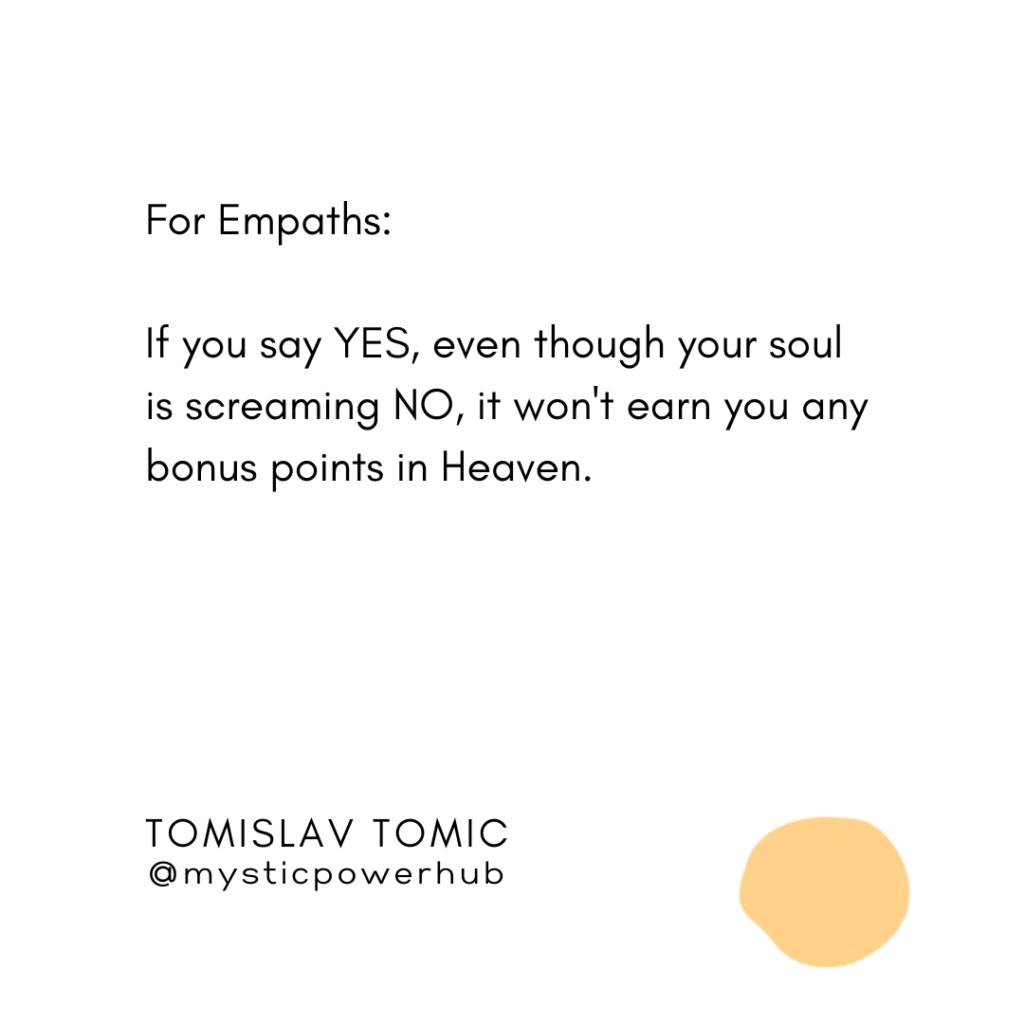Learn how to effectively say no as an empath without sacrificing your well-being. Discover why saying no is a crucial skill for maintaining balance and making conscious choices. Embrace discomfort as a catalyst for growth and view it as a gateway to empowered empathy. Overcome the feeling of guilt and understand that saying no doesn’t make you less compassionate, but ensures that your empathy remains sustainable. Follow a practical three-step strategy to communicate your no with kindness, emphasize limitations rather than rejecting the person or request, and gradually train your no “muscles” with smaller requests. Start mastering the art of saying no and reclaim your personal power.
(The content in this article has been transcribed from the video.)
If you identify as an empath, you may often hesitate to say “NO” when you feel that way because you don’t want to cause discomfort or disappoint someone.
Your innate desire to bring others joy and a good vibe is a wonderful gift desperately needed today. There’s no doubt about that. The problem, however, is that your reluctance to say “NO” when you feel like it often comes at the expense of your own well-being.
So, let me highlight something.
Contrary to popular belief, saying “NO” is not negative. It’s an essential skill that empowers you to maintain a healthy balance between your personal needs and the needs of others. Saying “NO” allows you to make conscious choices that align with your values and true desires.
If you want to be more efficient in saying “NO,” here’s something you should keep in mind because it represents the turning point in the art of saying NO. It’s actually a pivotal moment when the rubber meets the road.
And I’m talking about the feeling of discomfort because it can act like a powerful virus that robs you of your strength when you need it most.
First, let’s talk about discomfort and what it actually means. By my definition, the feeling of discomfort associated with “NO” is just an indicator that we are reacting in certain situations in a way that we are not used to. It’s as if your energy system is asking you if you want to respond in your old way or if you want to stick with your new response. In other words, it’s just an indicator of change. It is not a message from the Universe that you are doing something wrong. You can also see this discomfort as a catalyst for your growth because only when you embrace the discomfort can you make choices that truly meet your needs. Embracing the feeling of discomfort is actually your gateway to empowered empathy.
I hope this makes sense to you.

One more thing…
When you start practicing saying NO more often, in addition to the discomfort, you can expect your dear old friend to accompany you on your way. You can expect this friend to follow you faithfully in your endeavor. And I’m talking about the feeling of guilt. I know you’ve known each other for many years and have much to do with each other. So when your old friend comes up to you and says “hello,” keep in mind that saying “NO” doesn’t make you any less compassionate; instead, it ensures that your empathy remains a sustainable force. Otherwise, you’ll simply get drained. And there’s no alternative to that.
So, embracing the feelings of discomfort and guilt is an essential prerequisite for effectively saying “NO.” In other words, it’s the turning point to mastering the art of saying “NO. If you don’t define them – and I’m talking about discomfort and guilt – in a way that truly serves you, your NO will just sound weak. Even if you say it out loud, those words alone won’t have the power you need to make the change you want. Remember that words are only a small part of the information needed to get a message across.
Having said that, let’s discuss my practical three-step strategy for empaths to master the art of saying NO.
Three Step Strategy for Saying No
Express NO with Empathy
The first step is to communicate your “NO” with kindness. Say it as early as possible. Don’t wait too long. The less you wait to say NO, the easier it will be for you to say it with kindness. The longer you delay, the more discomfort you will feel and the harder it will be to say NO with empathy. Instead of saying your NO in “emphatic mode,” you will tend to say it more and more in “hysterical mode.” I remind you that the feeling of discomfort is only an indicator of change. It is not a message from the Universe that you are doing something wrong.
Emphasize your Limitations
The second step boils down to emphasizing your limitations rather than rejecting the person or request. I understand it’s a subtle difference, but it helps a lot in practice. For example, if someone invites you for a coffee after work and you don’t feel like that, instead of directly saying NO, you can say it this way: I’d like to have a coffee with you. However, I’ve set aside some personal time to recharge and unwind this evening.
For example, when given more responsibilities at work, instead of directly refusing, you can say something like this: “Thank you for trusting me with additional tasks. However, considering my existing workload and deadlines, I’m concerned that taking on more tasks could compromise the quality of my work. Can we discuss prioritizing or delegating some of these tasks?”
When you receive a social invitation, instead of declining directly, you can say something like: Thank you for inviting me to the event. Unfortunately, I have another commitment that day and can’t make it.
These were just a few examples to give you a basic idea. But the point is to keep playing and experimenting with it until you find the most effective way to highlight your limitations.
Start With Less Important Situations
The third step to refining your art of saying NO is to train your NO muscles with some smaller requests and gradually work your way up to more important requests. In other words, start practicing the art of saying NO by choosing situations that you find less important. This also applies to certain people you find less important. In this way, you’ll gradually get a feel for it and will be able to use it more and more often when you need to.
I hope you like this strategy and find it practical to master the art of saying NO.
Good luck 🙂
© 2023. Tomislav Tomic. All Rights Reserved.

